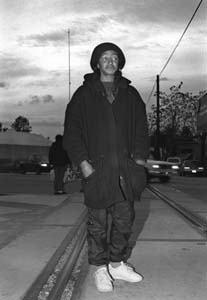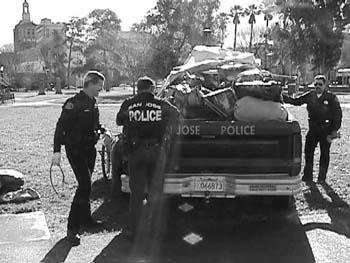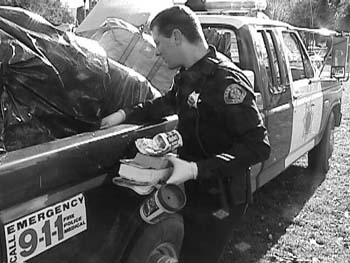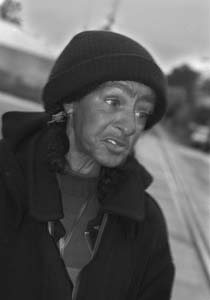Street Dreams
Christopher Gardner
'Mama' Fayette Bivings, the homeless queen of St. James Park, imagines a place where folks on the skids can slide into a better life.
By Michael Learmonth
STEADILY THE MOUND grew, until the bulging blue plastic tarp completely engulfed a park bench and almost became a San Jose landmark. Buried in boxes and as many as five shopping carts were all the necessities of life: apples, oranges and a thesaurus. Clorox, Fritos and winter coats. Cat food, Christmas cookies and Huggies.
Each day, as do-gooders pulled up to the curb to unload food and clothing, Mama Faye was there with open arms to accept the donations, which, in turn, swelled the size of her pile.
And as cold winter rains turned San Jose from Sicily to Seattle, homeless residents of St. James Park knew if they needed something, chances were Mama Faye could help.
"She gives away food and clothes," says William Sullivan, an unemployed painter. "She doesn't hoard it."
But as the mound grew, it became too much for the 53-year-old Fayette Bivings to manage on her own. She enlisted park youngsters like the 6-foot, 22-year-old David Dominucci to help with her convoy of shopping carts.
"I help her out every night to the steps," he says gesturing to Superior Court. "They let her sleep in the doorway."
But soon Mama Faye's pile drew the attention of neighbors, who complained to the police about the eyesore. Finally on Jan. 2, San Jose Police officers were sent to the scene, slapped on the latex gloves, arrested the diminutive Mama Faye, dismantled the mound and carted everything away in a Ford Bronco and an extended-cab pickup. Park residents kept a safe distance during the commotion.
"She'll be back," said a man who claimed it was the third time he'd witnessed the scene. "She comes back, builds it up and they come haul it away."
The last time she was arrested, Fayette Bivings laments, it was the day she was to perform in a scene in the movie Mad City, which was being filmed in front of the neoclassical Silicon Valley Athletic Club.
Sgt. Greg Trapp, head of the parks unit of the San Jose Police Department, wishes that the drive-by philanthropists who helped build up Mama Faye's cache would give instead to charities, which have the facilities to distribute the loot. When the pile gets too big, he says, his officers have no choice but to act.
"We only get involved when it becomes a public nuisance or a violation," Trapp says. "We had been warning her to start giving things away."
"I was trying to downsize," Mama Faye says sheepishly.
Keep on Truckin', Mama: Police returned Jan. 2 to move Faye Bivings' belongings out of St. James Park.
People's Park
IT'S BEEN FOUR WEEKS since Bivings' run-in with the police. Perched on her bench in the northeast corner of the park, she says she believes she is being harassed in an effort to get homeless people out of St. James Park.
"The San Jose police have decided that I'm the focal point," she says. "They think if they can break me, they can break the others."
Sue Cam is president of the Horace Mann Neighborhood Association and a member of an informal group she calls the "take back your park movement." The group meets for lunch at the McKinley statue on the first and third Tuesdays of the month.
"We feel very strongly that the people need to use the park and not be intimidated by the element that hangs out there," she says. "The more of us who use the park, the less there will be of the dopers and drug dealers. We need to run them off."
While Cam does not consider Mama Faye a criminal, her growing collection, Cam says, creates an eyesore and contributes to the park's social problems. Cam wishes the police would enforce rules against feeding homeless in the park and that people would stop making curbside donations to the people who spend their days there.
"She is not a dangerous element at all," Cam says of Mama Faye, "but she makes the park look like a dump."
Cam says that during one of the first lunch meetings, Mama Faye marched right up to the group, which included downtown Councilman David Pandori, and asked what they were doing there.
"It was like she owned the place," Cam says. "I told her we are simply enjoying our lunch here and plan to do it more often."
Carolyn Moseby directs the senior center in the park. She walks through the west side of the park to get to work.
Emergency Services: A trained law enforcement agent carefully stacks possessions in a police pickup truck.
"Oftentimes there are younger people sitting with their legs out," she says. "They don't move, so I have to walk around them. It's not very courteous."
For the most part, she says, the elderly people who use the center steer clear of the park. "Of course they are scared," she says. "People standing in groups can be intimidating."
She believes the key to making the park friendlier for everyone is planning more community events there to attract some of the "young single people" that she says live in apartments around the park.
Moseby is quick to point out that although some park denizens can be seen there every day, no one actually lives in the park. It's closed from dusk to dawn. Many of the patrons of the senior center are homeless and sleep in encampments like Mama Faye.
"I have street people who I know have camps," she says. They, like Mama Faye, choose to sleep outside instead of in shelters, especially in the winter months.
"She has places to go," Moseby says. "She just wants to be outside."
Moseby has seen Mama Faye care for babies during the day. "She has a nurturing personality," she says. "But instead of getting their help from [Mama Faye] they could go to agencies that could help them get further."
Moseby is happy that Mama Faye's pile is gone.
"It looked trashy," she says. "People come and feel sorry and they want things to be changed. Well, she's choosing that lifestyle. It doesn't seem right."
In response to the concerns of downtown businesses, the San Jose Downtown Association began convening community meetings about St. James Park last July. The association says its next meeting will take place in the park in late February, but a date has yet to be chosen.
The association is also considering duplicating a successful event that has become a tradition in the Plaza de Cesar Chavez, perhaps calling it "Music in the Other Park."
"We're looking at positive uses of the park to bring people there," says Noelle Knell, an association staffer.
Suggestions from the July meeting ranged from eliminating drug transactions and establishing more police visibility to building a petting zoo or a putting green.
Mama Faye's got her own ideas for the park. Before her belongings were taken away, she was collecting signatures to help her dream come true.
"We just want to use the Oasis until spring," she says. Her bench faces the long-closed nightclub on the corner of N. First and St. James streets. She speaks of "nonprofit status," "job training" and "grants." It's clear she's been mulling over this idea for a long time. Unemployed people who had been through the program would then commit to helping train others. She uses the example of a truck driver who would get training from the program, get a grant, start a trucking business and then train and employ others.
Mama Faye gets excited talking about her dream.
"Before Christ, during Christ and after Christ there's been homeless, but it doesn't have to be ugly," she says. "I came here by faith to make a community out of this park."
Christopher Gardner
Indian Giver
MAMA FAYETTE BIVINGS barely clears 5 feet or 100 pounds. She wears her black hair in braids down the sides of her gaunt face. She says she was born on Long Island to a Sioux father and a Delaware Indian mother. She came to San Jose "by faith" in 1978. Behind the braids, little silver kitty-cats hang from her ears.
A pained expression crosses her tiny face as she handles the earrings. Somewhere in that mammoth pile, Mama had a kitten. For a time, she also had a puppy named "Duke." She says she had decided to let Duke name the kitten, and he chose the name "Woof."
Talking about Woof causes Mama's dark eyes to fill up with tears. The police said that Woof would be "adopted out." But they also said Woof would be put to sleep if he wasn't adopted in three days. It's been four weeks since the police took Woof away, but Mama still hopes to see the cat again and hatches plans with other park residents to steal him back.
"How are you going to 'adopt out' my cat?" she pleads. "He's a free spirit. I don't own him; he owns me."
A mustachioed man with a Raiders jacket hobbles up to Mama Faye's bench walking with a cane.
"I'm off to physical therapy," he says, bending over and reaching down. "I just want a hug from my Mama." As he leaves, he bums a cigarette.
When Dominucci stops by, slamming his fist into his hand, she warns him to stay out of trouble. He says, "OK, Mama," takes a hug and smiles before he walks off.
Mama Faye says one thing she hates about talking to reporters is that inevitably, when the story is printed or broadcast, she ends up looking like a spokesperson or leader of the St. James Park homeless. But like it or not, a lot of park residents see her that way. She's smart, well-read (a crossword, a newspaper and as many as five books a day) and chatty. Other residents of the park, especially the younger ones, look up to her. During emergencies, it is to Mama that they turn.
"Mama, come over here!" a man yelled a few weeks ago. Mama walked over to find a young woman unconscious on the grass.
"What did she take?" she asked. No one knew. Mama evaluated the situation. "Well, if the ambulance comes, it'll cost money. But if it doesn't come, she'll be dead."
Mama Faye called 911 from a pay phone.
"I'm learning more about drugs, and I don't do any of them," she says. "At least this year we didn't have any depression. No one wanted to kill themselves."
Three of the park's young women are expecting, Mama Faye says, explaining the abundance of baby bottles, diapers, strollers and "receiving blankets" the police hauled away.
A year ago, Bivings says, she stood between two scared girls and a pimp and got punched in the face for her trouble. The blow shattered the bone around her left eye.
Usually, the only times she's afraid in the park are when the police come, she says, but otherwise "it's a beautiful park."
Some nights, she says, "you can listen to the fountain and be with your creator--whatever you call him, it's all the same energy."
Frustrated, she wonders aloud, "Why can't it be for people to rest their heads?"
[ San Jose | Metroactive Central | Archives ]
Copyright © Metro Publishing Inc. Maintained by Boulevards New Media.
![]()

Stand in the Place Where You Live: Mama Faye, a homeless woman in downtown San Jose, amassed a convoy of shopping carts full of food, clothing and household items to give away to other homeless people. Neighbors say it made historic St. James Park--once a stage for President William McKinley and the site of the city's last lynching--look like a dump.
Dan Pulcrano
Dan Pulcrano
Mama's Wish: Of her homeless-training dream, she says, 'We just want to use the Oasis until spring.'
From the February 5-11, 1998 issue of Metro.
![[Metroactive Features]](http://metroactive.com/features/gifs/feat468.gif)